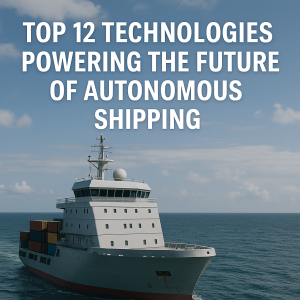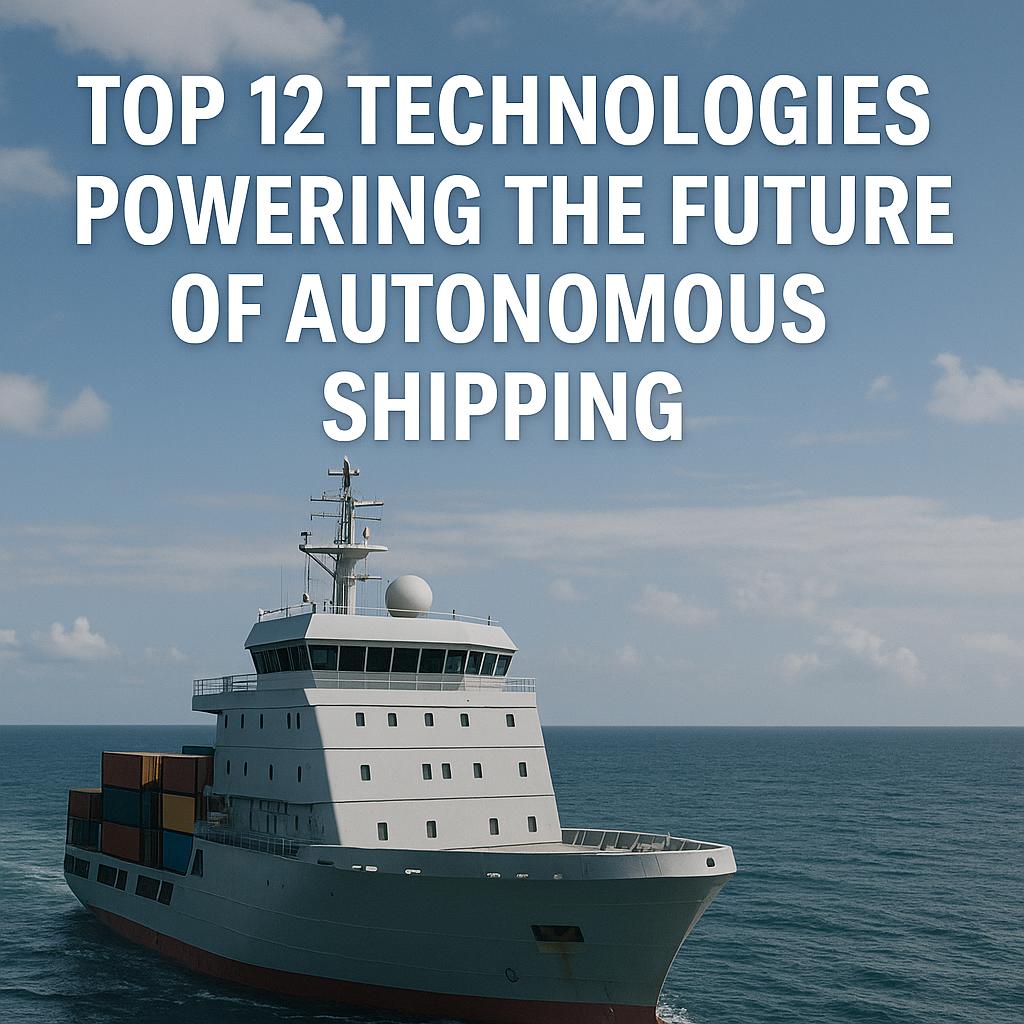
For decades, the idea of ships sailing themselves was the stuff of science fiction. Today, that fiction is quietly becoming reality. Autonomous shipping is moving from concept to commercial operation, promising a new era of safer, smarter, and more sustainable maritime transport.
From Norway’s fully electric Yara Birkeland container ship to European projects like AUTOSHIP, real vessels are now navigating coastal and inland waters with advanced automation. This shift is supported by global classification societies like DNV and Lloyd’s Register, which have established frameworks to ensure these new vessels are at least as safe as their conventional counterparts.
As the backbone of global trade—carrying around 80% of world trade by volume—the maritime sector is under immense pressure to decarbonize and digitalize. Autonomous technology is a critical piece of that puzzle.
But what exactly makes an autonomous ship tick? It’s not a single “magic brain” but a sophisticated stack of interconnected technologies. Here are the 12 core technologies driving this revolution.
The 12 Core Technologies of Autonomous Shipping
1. Perception: Advanced Sensor Suites & Fusion
An autonomous ship needs a superhuman sense of its environment, capable of “seeing” clearly in all conditions—day, night, fog, and heavy traffic. This is achieved not by a single sensor, but by a diverse suite that work together to create a comprehensive picture of the vessel’s surroundings. The crucial technology that ties it all together is sensor fusion, a software layer that intelligently merges the data streams, cross-checking and validating information to build a single, reliable view of the world, even if one sensor fails.
- Radar: For long-range detection and tracking.
- Optical & Thermal Cameras: For object classification and close-range awareness.
- LIDAR: For high-resolution 3D mapping, especially useful in port.
- AIS & VHF: To identify other vessels and receive navigational data.
2. Intelligence: AI Navigation & Decision-Making
If sensors are the eyes and ears, Artificial Intelligence (AI) is the brain that interprets the world and decides what to do next. These AI systems are trained on vast datasets of maritime traffic and simulated scenarios to handle complex cognitive tasks. They enable the vessel to not just follow a pre-set route, but to dynamically navigate, predict the behavior of others, and make rule-compliant decisions in real-time, ensuring safe and efficient passage.
- Route Planning: Optimizing paths for fuel efficiency, weather, and traffic rules (COLREGs).
- Collision Avoidance: Predicting other ships’ movements and executing safe, rule-compliant maneuvers.
- Behavior Prediction: Using historical AIS data to anticipate the actions of nearby vessels.
3. Foundation: High-Precision & Resilient Navigation (PNT)
Autonomous ships depend on knowing their exact position, but reliance on a single system like GPS is a critical vulnerability, as these signals can be jammed or spoofed. Resilient Positioning, Navigation, and Timing (PNT) is the solution, creating a robust and multi-layered foundation for navigation. By combining several systems, the vessel can maintain an accurate fix on its location even if one source is compromised, which is non-negotiable for safe autonomous operation near coasts, in traffic, and during precise maneuvers.
- Multi-constellation GNSS (GPS, Galileo, etc.)
- Inertial Navigation Systems (INS) to bridge GPS gaps
- Radar and visual matching against coastal features
- Backup systems like eLoran
4. Connectivity: VDES & Next-Gen Communication
A smart ship is only as good as its connection to the wider world. Autonomous vessels must seamlessly and reliably exchange huge amounts of data with shore control centers, other ships, and satellites. This requires a new generation of maritime connectivity that goes beyond traditional systems, offering higher bandwidth, lower latency, and robust security to enable real-time supervision, data transfer, and remote command capabilities.
- VDES (VHF Data Exchange System): An upgraded AIS that offers higher data rates and two-way communication.
- Satellite Links (including LEO constellations): Provide global coverage for real-time telemetry, video feeds, and remote commands.
5. Processing: Edge Computing & the “Internet of Ships”
Sending the vast streams of sensor data from a ship to the cloud for processing is impractical due to cost, bandwidth, and critical latency. The solution is edge computing, which puts powerful processors directly on the vessel. This allows the ship to process data locally, making instantaneous decisions for navigation and safety without waiting for a distant server, while also enabling a networked ecosystem known as the “Internet of Ships.”
- Real-time decisions (like instant collision avoidance) without latency.
- Onboard analytics for fuel optimization and predictive maintenance.
- Selective data upload to shore, saving bandwidth and cost.
6. Testing: Digital Twins & High-Fidelity Simulation
Before a single physical bolt is turned or a ship enters a crowded waterway, autonomous systems are rigorously tested and proven in a virtual world. A digital twin is a dynamic, data-linked virtual model of a ship or port that is used to simulate millions of nautical miles in every conceivable scenario. This technology drastically reduces the cost and risk of innovation, allowing for exhaustive testing of failure modes and system performance long before real-world deployment.
- Simulate millions of nautical miles in realistic conditions.
- Test failure scenarios (sensor loss, cyber-attacks) safely.
- Provide evidence to regulators and class societies.
7. Control: Remote Operation Centres (ROCs)
Fully unmanned ships are not left to their own devices; they are constantly supervised from shore-based Remote Operation Centres (ROCs). These high-tech facilities function as the “mission control” for autonomous fleets, where human operators can monitor multiple vessels, oversee their operations, and intervene if necessary. ROCs represent a fundamental shift in maritime roles, moving traditional bridge functions ashore to a centralized, technology-driven environment.
- Panoramic screens displaying live data, video feeds, and charts.
- Dedicated operator consoles for supervision and intervention.
- Secure communication links with vessels and ports.
8. The Interface: Smart Bridges & e-Navigation
For vessels that retain a crew, the bridge is being transformed from a collection of standalone instruments into an integrated decision-support hub. Smart bridges fuse data from navigation sensors, e-Navigation services, and AI planners into a single, intuitive interface. This empowers the crew to effectively supervise the autonomous systems, understand the AI’s reasoning, and maintain ultimate control, enabling a gradual and safe adoption of automation.
- E-Navigation data (weather, traffic, VTS messages) is seamlessly integrated.
- “Explainable AI” shows the reasoning behind suggested maneuvers.
- Crews can supervise autonomy and intervene when needed.
9. Power: Autonomous Engine & Energy Management
A vessel’s autonomy must extend beyond the bridge and into the engine room. Intelligent machinery monitoring and control systems manage the vessel’s core power and propulsion functions automatically. For all vessels, this means optimizing fuel use and responding to faults; for the new generation of electric ships, it involves sophisticated energy management to balance battery power with operational demands, ensuring the vessel always has the power it needs to operate safely.
- Propulsion, engines, and thrusters.
- Battery systems on electric vessels.
- Power distribution and load-shedding during faults.
10. Security: Maritime Cybersecurity
As ships become floating, connected data centers, they become potential targets for cyber-attacks. For an autonomous vessel, where a system compromise could directly lead to a physical incident, cybersecurity is not an IT issue but a core safety requirement. This involves building security into the vessel’s architecture from the ground up and maintaining vigilant, continuous monitoring to protect against evolving threats.
- “Security-by-design” architectures with segmented networks.
- Robust authentication for all communication links.
- Continuous monitoring and threat intelligence sharing.
11. Integration: Sea Traffic Management (STM)
Autonomous ships cannot operate in isolation; they must be fully integrated into the existing maritime traffic system. Sea Traffic Management (STM) is a concept that creates a shared, real-time information environment between all sea users. By exchanging intentions and data, STM provides the critical context that allows autonomous ships to navigate predictably and safely alongside conventional vessels, turning individual voyages into a coordinated, efficient system.
- Route intentions and arrival times.
- Dynamic navigational warnings.
- Berth availability.
12. Assurance: Classification & Testing Frameworks
The final, and perhaps most crucial, “technology” is the framework of trust and verification. Before an autonomous ship can carry cargo, its systems must be proven to be safe and reliable. Classification societies have developed new rules, notations, and testing methodologies specifically for this purpose, providing a clear and rigorous pathway to certify that an autonomous vessel is fit for service and poses no greater risk than a conventional one.
- Class notations (like DNV’s AROS) that define autonomy levels.
- Scenario-based testing in simulations to prove safety.
- Formal safety assessments tailored to autonomous operations.
–
References
All links should point to authoritative or official sources where available.
-
DNV. (2024). Autonomous and Remotely Operated Ships (AROS) class notation. DNV.
-
IMO. (2021–2024). MASS Regulatory Scoping Exercise and development of the MASS Code. International Maritime Organization.
-
Kongsberg Maritime & Massterly. (2022–2025). Technical notes and project information on Yara Birkeland, AUTOSHIP and remote operation centres.
-
UNCTAD. (2023, 2024). Review of Maritime Transport. United Nations Conference on Trade and Development.
-
IALA. (2017–2024). VHF Data Exchange System (VDES) technical descriptions and guidance. International Association of Marine Aids to Navigation and Lighthouse Authorities.
-
Lloyd’s Register. (2020–2024). Autonomy Levels (AL 0–AL 6) and related guidance notes. Lloyd’s Register Group.
-
STM Validation Project. (2019–2024). Sea Traffic Management – Concept and Results. Various European partners.
-
ClassNK, ABS, BV, RINA. (2020–2025). Guidance notes on cyber-enabled and autonomous ship systems.
-
European Commission & CINEA. (2019–2025). Project documentation for AUTOSHIP and other EU-funded autonomous shipping demonstrations.
-
Academic journals (e.g., Marine Policy, Journal of Marine Science and Engineering, WMU Journal of Maritime Affairs) – articles on autonomous navigation, digital twins, maritime cyber security, and human factors in ROC operations.


Very useful tips! I’m excited to implement them soon.
Excellent work! Looking forward to future posts.
This topic is usually confusing, but you made it simple to understand.
You’ve done a great job with this. I ended up learning something new without even realizing it—very smooth writing!
Great info.
Awesome blog.